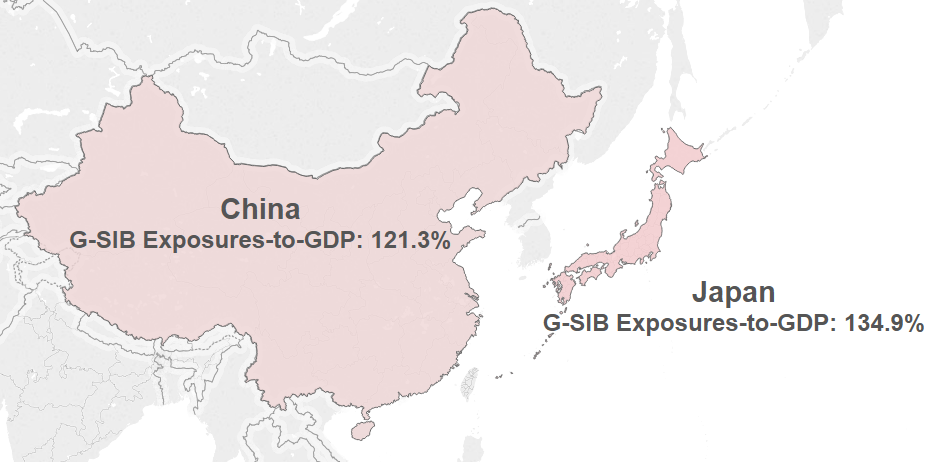The Financial Stability Board (FSB) recently updated its list of global systemically important banks (G-SIBs), adding China Construction Bank as the seventh Asian G-SIB. Including Standard Chartered, a U.K. incorporated bank with a majority of assets in Asia, more than a quarter of G-SIBs now operate primarily in Asia.
A casual observer might think of China’s massive state-controlled firms as the most systemically important banks in Asia. Indeed, the country’s four largest banks are among the G-SIBs and Industrial & Commercial Bank of China is the largest in the world by assets. However, measured by the FSB’s indicators of systemic importance, which consider a bank’s size, interconnectedness, complexity, substitutability, and cross-border activity, the most systemically important bank in Asia is Japanese.
Mitsubishi UFJ Financial Group (MUFG), the largest bank in Japan, ranks 11th in systemic importance among all G-SIBs according to the U.S. Treasury Department’s Office of Financial Research (see Table 1), which constructed a list of G-SIBs using the FSB methodology and most recently available data from year-end 2013. Two Chinese banks—Bank of China and Industrial & Commercial Bank of China—are next in systemic importance, with Mizuho Financial Group, the second largest bank in Japan, the only other Asian bank among the top 20. The OFR’s rankings are based on systemic importance scores, which range from 0 to 5; the FSB uses a similar methodology to determine capital surcharges applied to G-SIBs.
Table 1: Asian G-SIBs
| Institution | Country | Systemic Importance Score (0-5)* | Systemic Importance Rank | Global Assets as of 6/30/2015 (USD bn) | Global Assets Rank | G-SIB Capital Surcharge (2015)** |
|---|---|---|---|---|---|---|
| Mitsubishi UFJ Financial Group | Japan | 2.4 | 11 | 2,411 | 8 | 1.50% |
| Bank of China | China | 1.8 | 17 | 2,629 | 7 | 1.00% |
| Industrial and Commercial Bank of China | China | 1.8 | 17 | 3,615 | 1 | 1.00% |
| Mizuho Financial Group | Japan | 1.5 | 20 | 1,709 | 17 | 1.00% |
| Sumitomo Mitsui Financial Group | Japan | 1.4 | 25 | 1,567 | 19 | 1.00% |
| Agricultural Bank of China | China | 1.3 | 27 | 2,816 | 4 | 1.00% |
| Standard Chartered*** | UK | 1.3 | 27 | 695 | 41 | 1.00% |
| China Construction Bank | China | n/a | n/a | 2,938 | 2 | 1.00% |
Source: U.S. Treasury Office of Financial Research (Systemic Importance Score and rank), SNL (Global Assets), The Banker (Global Assets Rank).
* Systemic importance score calculated by U.S. Treasury using Basel Committee on Banking Supervision weighting methodology with latest available end-2013 data.
** G-SIB capital surcharge specified by the FSB.
*** As of end-2014, 64.5 percent of Standard Chartered’s global assets were located in Asia (SNL).
Asian G-SIBs are Large Relative to Their National Economies
Asian G-SIBs’ most common distinction is their size, measured as the bank’s overall exposures, including derivatives and securities financing.
According to SNL Financial estimates, Japanese G-SIB exposures represented 134.9 percent of Japan’s GDP as of end-2014, with Chinese exposures nearly equivalent at 121.3 percent of China’s GDP (see Figure 1). These two ratios are higher than U.S. G-SIBs’ (86.4 percent), despite the larger number of systemically important American banks, and only behind France (287.8 percent) and the United Kingdom (273.7 percent) among countries with at least three such banks. G-SIB designations are in part intended to discourage banks that are “too big to fail,” and a higher ratio of exposures-to-GDP indicates a greater economic burden—whether borne by public or private sources—to rescue important banks.
Figure 1: Asian G-SIB Exposures-to-GDP

Source: SNL Financial as of end-2014
Among the Japanese banks, MUFG scores highly because of its large overall size and substantial cross-border activity, measured by its level of foreign claims and liabilities; overseas operations accounted for roughly 40 percent of MUFG’s total assets and nearly half of revenues for the most recent fiscal year. Mizuho is also relatively large compared to G-SIB peers, but otherwise below average among G-SIBs across other indicators, as is Sumitomo Financial Group.
Measured by asset size alone, Chinese banks would easily lead the G-SIB ranks. When accounting for broader exposures, however, China’s largest banks, while still among the 10 largest G-SIBs, are joined by peers like J.P Morgan Chase, HSBC, and MUFG. Unique among the major Chinese banks, Bank of China scores highly for its cross-border activity, a result of its historical focus on foreign exchange transactions and international trade finance.
Where Asian Banks are Less Systemically Important
Asian G-SIBs are more “substitutable” than their non-Asian peers. In the language of the FSB, this means that in the event of distress or failure, their customers—including other banks—can find substitute banks with relative ease. The substitutability score takes into account a bank’s involvement in payments and underwriting activity as well as the assets it holds under custody for other customers. Several Asian G-SIBs like MUFG and the Bank of China have significant global payments activity. However, Asian banks have low underwriting activity, which reflects the bank-centric nature of the Chinese and Japanese financial systems. Moreover, the larger role of non-Asian banks in regional custody management limits Asian banks’ involvement in this business.
The Asian G-SIBs are also considered less complex than their peers. The FSB’s definition of complexity is, well, complex. It considers banks’ over-the-counter derivatives and other less liquid assets as well as their overall holdings of securities classified as trading or available-for-sale. Compared to peers, Asia’s large banks tend to have simpler balance sheets. On the asset side, they hold large levels of loans, government bonds, and cash. On the liabilities side, they are funded largely by core deposits.
Readiness for Basel III G-SIB Rules
With increasing systemic importance, home and host country regulators are paying increasing attention to Asian banks’ resiliency in the event of a crisis.
Asian banks are generally well capitalized, and the G-SIBs are no exception. For the Japanese banks, total capital and tier 1 capital ratios were 15.62 and 12.34 percent, respectively, as of fiscal year-end March 31, 2015. For Chinese banks, the respective ratios were 14.02 percent and 11.28 percent as of fiscal year-end December 31, 2014. These levels of capitalization position the banks to meet Basel III capital adequacy requirements when fully implemented by 2019 (see Table 2), although they are below G-SIB peer averages of 15.77 and 13.05 percent, respectively.
Table 2: Asian G-SIB Capital Adequacy
| Japan | China | Peer | 2019 Requirement | |
|---|---|---|---|---|
| Basel III – Tier 1 Regulatory Capital Ratio | 12.34 | 11.28 | 13.05 | 6.00 |
| Basel III – Total Regulatory Capital Ratio | 15.62 | 14.02 | 15.77 | 10.50* |
Source: SNL
* Including capital conservation buffer.
New rules on total loss absorbing capacity (TLAC) will require systemically important banks to hold a substantial share of so-called “bail-in” debt instruments. In a crisis, these instruments can be written down or converted into equity so that equity and debt investors absorb losses and taxpayer bailouts can be avoided. Banks in the United States and Europe typically already fund themselves with a large share of bonds, though they will have to issue new TLAC-eligible bonds to meet the requirement. Asian G-SIBs, which largely rely on deposits to fund their activities, will need to issue more debt instruments than their global peers.
Chinese G-SIBs will need to raise an estimated EUR 355 billion according to FSB estimates, roughly one-third of the total global shortfall. They will have until 2028, an extra six years compared to global peers, to raise the debt, an acknowledgment of the still-limited depth of China’s bond markets. Japanese G-SIBs face less pressure, as they will receive credit for reserves against deposit losses held by Japan’s deposit insurance scheme.
Asian G-SIBs will benefit from their large deposits, which help banks fulfill new Basel III requirements on liquidity. Both the liquidity coverage ratio (LCR), which ensures banks hold sufficient liquid assets to cover expected 30-day cash outflows, and the net stable funding ratio (NSFR), which serves a similar purpose with regard to expected outflows within 365 days, credit banks with a large base of stable deposits.
Conclusion
Asia’s largest banks are among the world’s most systemically important, particularly in size and cross-border activity. The continued economic growth and financial opening of China will only increase the systemic importance of that country’s banks, while the return of Japanese banks’ cross-border lending entrenches their global role. In the years to come, this increasing footprint will have major implications for the world economy, global financial system, and national regulatory regimes.
The views expressed here do not necessarily reflect the views of the management of the Federal Reserve Bank of San Francisco or of the Board of Governors of the Federal Reserve System.
